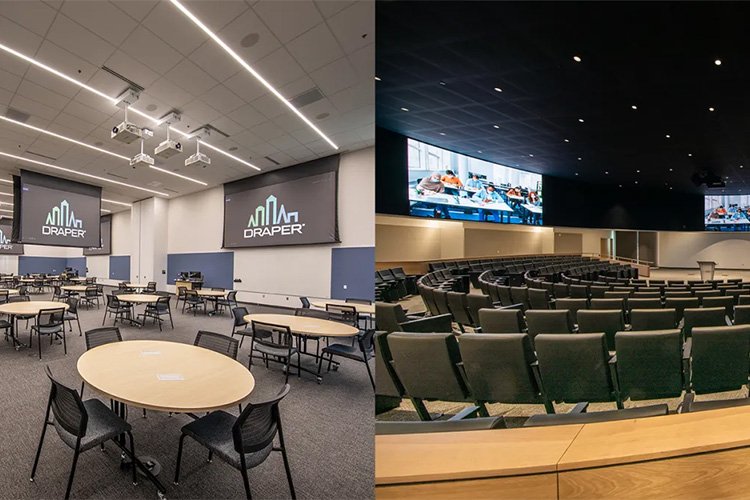Technological advances lead to updates in image standards
December 2, 2022

Featured image: Projection screens and dvLED video walls at the Arizona State University Health Futures Center. Architect: CO Architects. Integrator & Installer: Spinitar. Photographer: Matt O – mattophoto.net.
Display technology has changed so much over the past decade that old image standards and practices have come obsolete.
That’s why AVIXA, the pro AV and information communications trade association, has released a new standard for image system contrast ratio. Formerly known as PISCR, the new standard is simply ISCR.
PISCR applied only to projection systems. The updated standard includes flat panel displays as well.
“Previously, while direct-view displays were a strong part of the industry, projection-based display technology still influenced the majority of large format installations at that time,” said Jonathan Brawn, CTS, Principal, Brawn Consulting, and co-chair of this standard’s task group, in a recent press release. “Today, direct-view technologies like very large format LCD, LCD videowalls, and increasingly, DVLED have not only maintained being mainstream but are now the dominant technology in most instances.”

Sequential testing looks at system contrast from several locations in the viewing area.
The only major difference between the older and newer standards is the inclusion of a new method for measuring system contrast ratio. PISCR called for measuring contrast using the so-called “checkerboard” test.
The standard task group decided sequential, or full on/off or inter-frame testing, more accurately characterizes image system contrast across technologies and display environments.
While Draper TecVision premium projection surfaces will still help a display system meet the updated standard, it also underscores the importance of complete system performance and the need to correct installation of LED video walls and other flat displays.
“With direct display technology, especially direct view LED, obtaining proper system performance including contrast ratio is more than just a question of the video technology specifications,” said Grant Wylie, director of AVMS product management for Draper. “A precision engineered, minutely adjustable mounting system is also important to creating a flawless experience in any display environment.”
To learn more about Draper TecVision, click here.
To explore our mounting structure options for LED, click here.
To learn more about the ISCR standard, visit the AVIXA website.
@Draperinc #Draperinc #AVTweeps #AV
Company:  Draper, Inc.
Draper, Inc.
Product: Projection Screens
Source: https://blog.draperinc.com/2022/11/technological-advances-lead-to-updates-in-image-standards/
Tags:
Audio Visual
5 Problems Solved By Modern Projection Screen Technology (December 13, 2021), Offering the freedom to install seamless ALR screens up to 16 feet in height, Parallax Stratos is a Contrast Based ALR surface that rejects up to 80 percent of ambient light (March 27, 2019), Five incredibly smart, small, and simple AV ideas (November 19, 2018), How Ambient Light Rejection (ALR) works: clearing the confusion (March 21, 2018), Updated projection screen science (December 28, 2017), Fast-Fold NXT Screen System (November 16, 2017), Stagescreen Portable Projection Screen® (September 12, 2017), Creating the perfectly flat viewing surface (July 11, 2017), Video Surveillance In 2017: 4 Things You Need To Know (July 7, 2017), Striking the Right Color Balance in ALR Screens (April 10, 2017)

